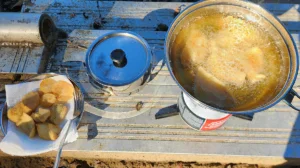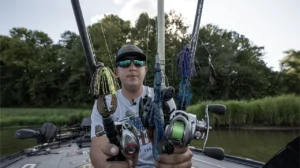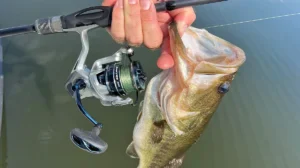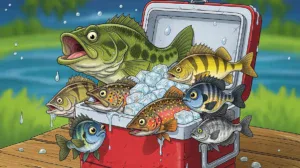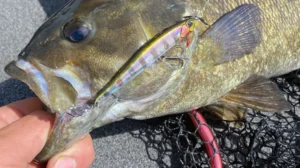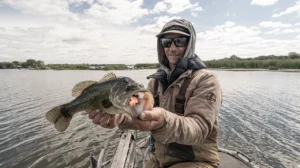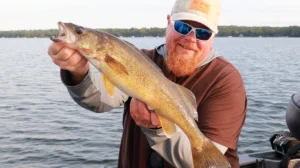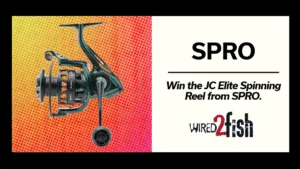I’ll admit I’m not a professional walleye angler. When I do catch them, it’s typically as a bonus while I’m focused on bass or perch. These catches are always welcome, as most of the walleye I bring aboard my boat are destined for the freezer. They are extremely flavorsome fish. Anglers nationwide have them on their minds, resulting in millions being caught and filleted annually. During the summer months, one highly effective technique stands out.
I recently fished with my good friends Scott and Luke Brauer, former owners of Maki Plastics (now produced by Clam Outdoors), on a walleye trip to Lake Erie. This season was a banner year for the lake. Thousands of anglers flocked to Lake Erie to get in on the great action. Countless limits of delicious walleyes were filled by 9 a.m. using one lone technique — bottom bouncing. Let’s discuss what bottom bouncing is, plus tips and tactics to execute while bouncing for big walleyes.
What is Bottom Bouncing?

When I first heard of the technique, I thought bottom bouncing was a trolling technique focused toward the bottom. I was right to a degree, but there’s still plenty of nuance and variety to the bottom-bouncing rig. Thankfully, they all put fish in the boat. It’s a technique that’s foolproof; you can try it anywhere there are walleyes around.
A bottom-bouncing setup is essentially a rig consisting of a weight with a wire feeler arm, paired to a long leader with a “harness.” The nightcrawler harness consists of two snelled hooks in tandem with beads in line with a spinner blade. Other variations of the rig exist as well.
According to National Walleye Tour New York pro Craig Sleeman, “Bottom bouncers are the most efficient and consistently effective way to put walleyes in the boat.” Sleeman has used bottom bouncers all over the country, from the 1000 Islands all the way to the Midwest. They’ve accounted for more walleyes in his boat than any other technique.
What Factors Determine Bottom Bouncing Success?

Many anglers think fishing with bottom bouncers is simply dropping them to the bottom and you’re instantly catching fish. That couldn’t be farther from the truth. There are many different factors you need to consider before getting a bite. Here are some of the most important considerations in determining how to fish your bottom bouncers.
Speed
When it comes to working the bottom for walleyes, the speed at which you drift is super important. You don’t want to be so slow that the blades on the harness don’t spin, but you don’t want it to be too fast that the bait looks unnatural. Sleeman loves to keep his bottom bouncing speed between 1.4 and 1.6 mph. You can either achieve that by using your kicker outboard or your trolling motor. Sleeman uses his Minn Kota Ultrex trolling motor with a remote to set his speed using the autopilot feature. That way, you stay at the same speed at all times and can make quick adjustments on the fly.
Weight
Of course, your bait needs to be on the bottom. That’s why it’s called bottom bouncing. Having the right amount of lead makes all the difference in the world. Having too heavy or too light of a weight will affect the way the harness sits on the bottom. Too light, and your bait will fall way behind the boat and you won’t feel bottom. Too heavy, and your bait won’t act naturally on the bottom.
Sleeman says, “To fish a bottom bouncer correctly, follow the 10:1 rule. For every ten feet of water you have below the boat, you should have at least one ounce of weight.”
For example, if the walleyes are sitting in 80 feet of water on the bottom, you should be using an eight-ounce bottom bouncer. You’re dividing the depth of the water by 10 to pick the weight (in ounces) of your bottom bouncer. Bass Pro Shops sells premade Bottom Bouncers from ½ to 3 ounces. Erie Bottom Bouncers makes a variety of weighted bottom bouncers too, including heavy options from 6 to 16 ounces.
Color, Shape and Size

Now that you’ve found the right size bottom bouncer, you need the right color, shape and size of blade to fit your worm harness. From Sleeman’s perspective, these are the three most important factors to getting more bites. Walleyes are finicky creatures, sometimes even more so than smallmouth.
Finding the right combination of blades is crucial in getting more bites. Blades come in Colorado, Indiana, and willowleaf shapes, plus a plethora of different colors. Sleeman always says that the size and action of the blade is more important than the color. Each blade shape throws off a different vibration. Northland Fishing Tackle offers Colorado and Indiana blades, some even with baitfish-image color patterns. Walleye Nation Creations produces custom blades too, but tried and true colors like watermelon, gold and silver also catch plenty.
Whether you build your own harness rigs or buy them premade in the store, make sure they have quick changes to switch your blades on the fly. That allows you to shuffle blades to find the best color of the day and put more fish in the box.
Presentation and Boat Setup
“Having the right presentation will make or break your day of walleye fishing, whether it’s cashing a check in a tournament or trying to fill the freezer” says Sleeman. When bottom bouncing, you need to keep the rigs at the right angle away from the boat. Too far, and they will have the opportunity to get snagged. Too close, and the rigs will be ricocheting off the bottom. You want to find that sweet spot, which is about 45 degrees away from the boat. Not too far or too close, but just perfect to present a natural presentation to these fussy fish.
When setting your rods up on the boat, you can have as many rods as you want, but remember that too many rods cause tangles. The few days we fished on Erie with bottom bouncers, we ran four rods — two out the back and two off the side. On the back rods we ran lighter bottom bouncers and the sides, we ran a few ounces heavier. This ensured all of them on the bottom, positioned at that magical 45 degree angle from the boat.
Rod, Reel and Line Setup

It’s important to have the right setup to feel the bite, but also heavy enough to handle the weight of the bouncer itself. Rods in the 7-foot, 6-inch to 8-foot-plus range, built with medium action and moderate fast tapers, work perfectly. For example, Fenwick’s HMG walleye rod is available at 7-and-a-half feet, with moderate action and medium weight. The stick needs to feel the bites, but not handle like a pool cue. Sleeman choices the Douglas LRS, as it has the right action and taper to feel every bite, whether holding the rod or in a rod holder.
Line counter reels are also a must for this type of fishing, mainly to replicate your spread every time you get bit. If you get a hit 126 feet away from the boat, then it’s important to put your baits back at that mark. Okuma makes a wide array of line counter reels that many walleye professionals use, but there is one that stands out from the rest. The Okuma Coldwater low profile line counter reel provides a comfortable feel in your hand, while the push button allows you to let out line quickly.
Since you’re usually connecting the mainline directly to the three-way swivel or bottom bouncer arm, having a no stretch line is key. Spooling up with a 20- to 30-pound braided line, such as Berkley X5 or Berkley X9, will do the trick just fine. The only way you’d want any stretch in your line is at your rig leader, in which case the 15- to 20-pound Yo-Zuri SuperFluoro fluorocarbon leader works well.
So get out there before the weather turns cold. Bottom bouncing for walleyes requires efficiency like a well-oiled machine. Everything has to be dialed in to keep the bite consistent throughout the day. But it can be the most effective way to catch both limits of walleyes and big ones too.


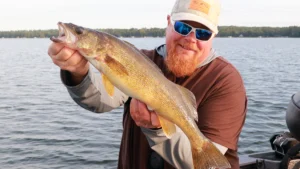
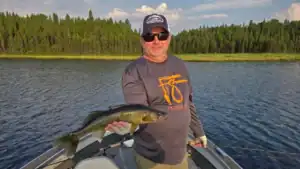
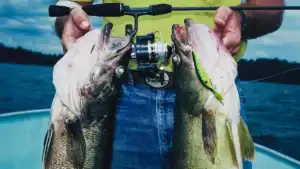
![[VIDEO] Power Fishing Walleyes With Moving Baits on Big Water](https://www.wired2fish.com/wp-content/uploads/2025/04/power-fishing-walleyes-300x169.webp)
